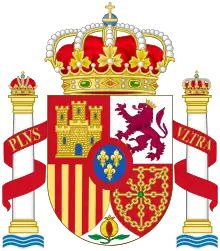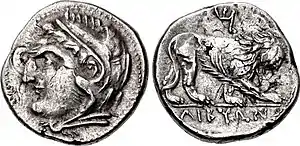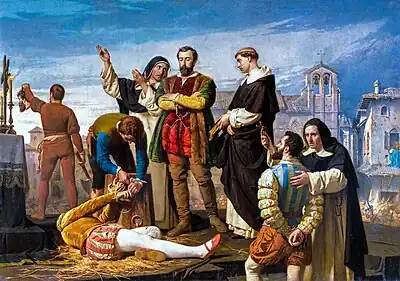Portal:Spain
Portal maintenance status: (June 2018)
|
The Spain Portal (Bienvenido al portal español)
Spain (Spanish: España, [esˈpaɲa] ⓘ), or the Kingdom of Spain (Reino de España), is a country located in Southwestern Europe, with parts of its territory in the Atlantic Ocean, the Mediterranean Sea and Africa. It is the largest country in Southern Europe and the fourth-most populous European Union member state. Spanning across the majority of the Iberian Peninsula, its territory also includes the Canary Islands in the Atlantic Ocean, the Balearic Islands in the Mediterranean Sea, and the autonomous cities of Ceuta and Melilla in Africa. Spain is bordered to the north by France, Andorra, and the Bay of Biscay; to the east by the Mediterranean Sea; to the south by Morocco in Ceuta and Melilla, and the United Kingdom in Gibraltar; and to the west by Portugal and the Atlantic Ocean. Spain's capital and largest city is Madrid; other major urban areas include Barcelona, Valencia, Zaragoza, Seville, Málaga, Murcia, Palma de Mallorca, Las Palmas de Gran Canaria, and Bilbao.
In early antiquity, the Iberian Peninsula was inhabited by a mixture of Iberian and Celtic tribes, along with other local pre-Roman peoples. With the Roman conquest of the Iberian Peninsula, the province of Hispania was established. Following the Romanization and Christianization of Hispania, the fall of the Western Roman Empire ushered in the inward migration of tribes from Central Europe, including the Visigoths, who formed the Visigothic Kingdom centred on Toledo. In the early eighth century, most of the peninsula was conquered by the Umayyad Caliphate, and during early Islamic rule, Al-Andalus became a dominant peninsular power centred in Córdoba. Several Christian kingdoms emerged in Northern Iberia, chief among them Asturias, León, Castile, Aragon, Navarre and Portugal; made an intermittent southward military expansion, known as the Reconquista, repelling Islamic rule in Iberia, which culminated with the Christian seizure of the Nasrid Kingdom of Granada in 1492. The dynastic union of the Crown of Castile and the Crown of Aragon in 1479 is often considered the formation of Spain as a country. (Full article...)
 Featured article –
Featured article –
 Image 1
Image 1
The Mercenary War, also known as the Truceless War, was a mutiny by troops that were employed by Carthage at the end of the First Punic War (264–241 BC), supported by uprisings of African settlements revolting against Carthaginian control. It lasted from 241 to late 238 or early 237 BC and ended with Carthage suppressing both the mutiny and the revolt. (Full article...) Image 2
Image 2
Joseph Anton Lopez SJ (born José Antonio López; October 4, 1779 – October 5, 1841) was a Mexican Catholic priest and Jesuit. Born in Michoacán, he studied canon law at the Colegio de San Nicolás and the Royal and Pontifical University of Mexico. He became acquainted with the future Empress consort Ana María Huarte and was made chaplain to the future imperial family. He was later put in charge of the education of all the princes in Mexico. Lopez was a close ally of Emperor Agustín de Iturbide, residing in Madrid for four years as his attorney and political informant, and accompanying him during his exile to Italy and England. (Full article...) Image 3Muhammad II (Arabic: محمد الثاني) (also known by the epithet al-Faqih, "the canon-lawyer", c. 1235 – 8 April 1302; reigned from 1273 until his death) was the second Nasrid ruler of the Emirate of Granada in Al-Andalus on the Iberian Peninsula, succeeding his father, Muhammad I. Already experienced in matters of state when he ascended the throne, he continued his father's policy of maintaining independence in the face of Granada's larger neighbours, the Christian kingdom of Castile and the Muslim Marinid state of Morocco, as well as an internal rebellion by his family's former allies, the Banu Ashqilula. (Full article...)
Image 3Muhammad II (Arabic: محمد الثاني) (also known by the epithet al-Faqih, "the canon-lawyer", c. 1235 – 8 April 1302; reigned from 1273 until his death) was the second Nasrid ruler of the Emirate of Granada in Al-Andalus on the Iberian Peninsula, succeeding his father, Muhammad I. Already experienced in matters of state when he ascended the throne, he continued his father's policy of maintaining independence in the face of Granada's larger neighbours, the Christian kingdom of Castile and the Muslim Marinid state of Morocco, as well as an internal rebellion by his family's former allies, the Banu Ashqilula. (Full article...) Image 4
Image 4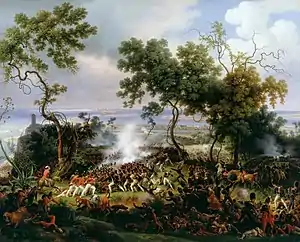 Battle of Chiclana, 5 March 1811, Louis-François Lejeune
Battle of Chiclana, 5 March 1811, Louis-François Lejeune
The Battle of Barrosa (Chiclana, 5 March 1811, also known as the Battle of Chiclana or Battle of Cerro del Puerco) was part of an unsuccessful manoeuvre by an Anglo-Iberian force to break the French siege of Cádiz during the Peninsular War. During the battle, a single British division defeated two French divisions and captured a regimental eagle. (Full article...) Image 5
Image 5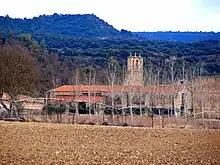 The ruins of Santa María de Óvila in Spain, shown more than 75 years after the most striking architectural features were removed by agents of William Randolph Hearst
The ruins of Santa María de Óvila in Spain, shown more than 75 years after the most striking architectural features were removed by agents of William Randolph Hearst
Santa María de Óvila is a former Cistercian monastery built in Spain beginning in 1181 on the Tagus River near Trillo, Guadalajara, about 90 miles (140 km) northeast of Madrid. During prosperous times over the next four centuries, construction projects expanded and improved the small monastery. Its fortunes declined significantly in the 18th century, and in 1835 it was confiscated by the Spanish government and sold to private owners who used its buildings to shelter farm animals. (Full article...) Image 6
Image 6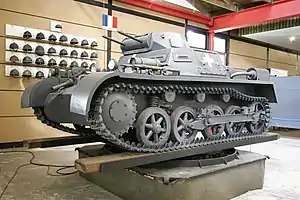 A Wehrmacht Panzerkampfwagen I Ausf. A light tank on display at the Deutsches Panzermuseum Munster in Munster, Germany.
A Wehrmacht Panzerkampfwagen I Ausf. A light tank on display at the Deutsches Panzermuseum Munster in Munster, Germany.
The Panzer I was a light tank produced by Nazi Germany in the 1930s. Its name is short for Panzerkampfwagen I (German for "armored fighting vehicle mark I"), abbreviated as PzKpfw I. The tank's official German ordnance inventory designation was Sd.Kfz. 101 ("special purpose vehicle 101"). (Full article...) Image 7Nasr (1 November 1287 – 16 November 1322), full name Abu al-Juyush Nasr ibn Muhammad (Arabic: أبو الجيوش نصر بن محمد), was the fourth Nasrid ruler of the Emirate of Granada from 14 March 1309 until his abdication on 8 February 1314. He was the son of Muhammad II al-Faqih and Shams al-Duha. He ascended the throne after his brother Muhammad III was dethroned in a palace revolution. At the time of his accession, Granada faced a three-front war against Castile, Aragon and the Marinid Sultanate, triggered by his predecessor's foreign policy. He made peace with the Marinids in September 1309, ceding to them the African port of Ceuta, which had already been captured, as well as Algeciras and Ronda in Europe. Granada lost Gibraltar to a Castilian siege in September, but successfully defended Algeciras until it was given to the Marinids, who continued its defense until the siege was abandoned in January 1310. James II of Aragon sued for peace after Granadan defenders defeated the Aragonese siege of Almería in December 1309, withdrawing his forces and leaving the Emirate's territories by January. In the ensuing treaty, Nasr agreed to pay tributes and indemnities to Ferdinand IV of Castile and yield some border towns in exchange for seven years of peace. (Full article...)
Image 7Nasr (1 November 1287 – 16 November 1322), full name Abu al-Juyush Nasr ibn Muhammad (Arabic: أبو الجيوش نصر بن محمد), was the fourth Nasrid ruler of the Emirate of Granada from 14 March 1309 until his abdication on 8 February 1314. He was the son of Muhammad II al-Faqih and Shams al-Duha. He ascended the throne after his brother Muhammad III was dethroned in a palace revolution. At the time of his accession, Granada faced a three-front war against Castile, Aragon and the Marinid Sultanate, triggered by his predecessor's foreign policy. He made peace with the Marinids in September 1309, ceding to them the African port of Ceuta, which had already been captured, as well as Algeciras and Ronda in Europe. Granada lost Gibraltar to a Castilian siege in September, but successfully defended Algeciras until it was given to the Marinids, who continued its defense until the siege was abandoned in January 1310. James II of Aragon sued for peace after Granadan defenders defeated the Aragonese siege of Almería in December 1309, withdrawing his forces and leaving the Emirate's territories by January. In the ensuing treaty, Nasr agreed to pay tributes and indemnities to Ferdinand IV of Castile and yield some border towns in exchange for seven years of peace. (Full article...) Image 8
Image 8
The Third of May 1808 (also known as El tres de mayo de 1808 en Madrid or Los fusilamientos de la montaña del Príncipe Pío, or Los fusilamientos del tres de mayo) is a painting completed in 1814 by the Spanish painter Francisco Goya, now in the Museo del Prado, Madrid. In the work, Goya sought to commemorate Spanish resistance to Napoleon's armies during the occupation of 1808 in the Peninsular War. Along with its companion piece of the same size, The Second of May 1808 (or The Charge of the Mamelukes), it was commissioned by the provisional government of Spain at Goya's own suggestion shortly after the ousting of the French occupation and the restoration of King Ferdinand VII. (Full article...) Image 9
Image 9 The western Mediterranean in 218 BC
The western Mediterranean in 218 BC
The Second Punic War (218 to 201 BC) was the second of three wars fought between Carthage and Rome, the two main powers of the western Mediterranean in the 3rd century BC. For 17 years the two states struggled for supremacy, primarily in Italy and Iberia, but also on the islands of Sicily and Sardinia and, towards the end of the war, in North Africa. After immense materiel and human losses on both sides, the Carthaginians were defeated. Macedonia, Syracuse and several Numidian kingdoms were drawn into the fighting, and Iberian and Gallic forces fought on both sides. There were three main military theatres during the war: Italy, where Hannibal defeated the Roman legions repeatedly, with occasional subsidiary campaigns in Sicily, Sardinia and Greece; Iberia, where Hasdrubal, a younger brother of Hannibal, defended the Carthaginian colonial cities with mixed success before moving into Italy; and Africa, where Rome finally won the war. (Full article...) Image 10
Image 10 The Battle of Pavia, by an unknown Flemish artist
The Battle of Pavia, by an unknown Flemish artist
The Italian War of 1521–1526, sometimes known as the Four Years' War, (French: Sixième guerre d'Italie) was a part of the Italian Wars. The war pitted Francis I of France and the Republic of Venice against the Holy Roman Emperor Charles V, Henry VIII of England, and the Papal States. It arose from animosity over the election of Charles as Emperor in 1519–1520 and from Pope Leo X's need to ally with Charles against Martin Luther. (Full article...)![Image 11Las Meninas (Spanish for 'The Ladies-in-waiting' pronounced [las meˈninas]) is a 1656 painting in the Museo del Prado in Madrid, by Diego Velázquez, the leading artist of the Spanish Baroque. It has become one of the most widely analyzed works in Western painting with qn elusive composition Velazquez seeking to bridge art and reality, between the subjects and the viewer as well as a declaring painting as one of the liberal arts. (Full article...)](../I/Blank.png.webp) Image 11Las Meninas (Spanish for 'The Ladies-in-waiting' pronounced [las meˈninas]) is a 1656 painting in the Museo del Prado in Madrid, by Diego Velázquez, the leading artist of the Spanish Baroque. It has become one of the most widely analyzed works in Western painting with qn elusive composition Velazquez seeking to bridge art and reality, between the subjects and the viewer as well as a declaring painting as one of the liberal arts. (Full article...)
Image 11Las Meninas (Spanish for 'The Ladies-in-waiting' pronounced [las meˈninas]) is a 1656 painting in the Museo del Prado in Madrid, by Diego Velázquez, the leading artist of the Spanish Baroque. It has become one of the most widely analyzed works in Western painting with qn elusive composition Velazquez seeking to bridge art and reality, between the subjects and the viewer as well as a declaring painting as one of the liberal arts. (Full article...)
 Image 12
Image 12.jpg.webp) Conquistador Pedro de Alvarado led the initial efforts to conquer Guatemala.
Conquistador Pedro de Alvarado led the initial efforts to conquer Guatemala.
In a protracted conflict during the Spanish colonization of the Americas, Spanish colonisers gradually incorporated the territory that became the modern country of Guatemala into the colonial Viceroyalty of New Spain. Before the conquest, this territory contained a number of competing Mesoamerican kingdoms, the majority of which were Maya. Many conquistadors viewed the Maya as "infidels" who needed to be forcefully converted and pacified, disregarding the achievements of their civilization. The first contact between the Maya and European explorers came in the early 16th century when a Spanish ship sailing from Panama to Santo Domingo was wrecked on the east coast of the Yucatán Peninsula in 1511. Several Spanish expeditions followed in 1517 and 1519, making landfall on various parts of the Yucatán coast. The Spanish conquest of the Maya was a prolonged affair; the Maya kingdoms resisted integration into the Spanish Empire with such tenacity that their defeat took almost two centuries. (Full article...) Image 13Muhammad III (Arabic: محمد الثالث; 15 August 1257 – 21 January 1314) was the ruler of the Emirate of Granada in Al-Andalus on the Iberian Peninsula from 8 April 1302 until 14 March 1309, and a member of the Nasrid dynasty. He ascended the Granadan throne after the death of his father Muhammad II, which according to rumours, was caused by Muhammad III poisoning him. He had the reputation of being both cultured and cruel. Later in his life, he became visually impaired—which caused him to be absent from many government activities and to rely on high officials, especially the powerful Vizier Ibn al-Hakim al-Rundi. (Full article...)
Image 13Muhammad III (Arabic: محمد الثالث; 15 August 1257 – 21 January 1314) was the ruler of the Emirate of Granada in Al-Andalus on the Iberian Peninsula from 8 April 1302 until 14 March 1309, and a member of the Nasrid dynasty. He ascended the Granadan throne after the death of his father Muhammad II, which according to rumours, was caused by Muhammad III poisoning him. He had the reputation of being both cultured and cruel. Later in his life, he became visually impaired—which caused him to be absent from many government activities and to rely on high officials, especially the powerful Vizier Ibn al-Hakim al-Rundi. (Full article...) Image 14
Image 14.jpg.webp) Alfonso XIII in 1932, after having been renamed España
Alfonso XIII in 1932, after having been renamed España
Alfonso XIII was the second of three España-class dreadnought battleships built in the 1910s for the Spanish Navy. Named after King Alfonso XIII of Spain, the ship was not completed until 1915 owing to a shortage of materials that resulted from the start of World War I the previous year. The España class was ordered as part of a naval construction program to rebuild the fleet after the losses of the Spanish–American War; the program began in the context of closer Spanish relations with Britain and France. The ships were armed with a main battery of eight 305 mm (12 in) guns and were intended to support the French Navy in the event of a major European war. (Full article...)![Image 15Futbol Club Barcelona (Catalan pronunciation: [fubˈbɔl ˈklub bəɾsəˈlonə] ⓘ), commonly referred to as Barcelona and colloquially known as Barça ([ˈbaɾsə]), is a professional football club based in Barcelona, Catalonia, Spain, that competes in La Liga, the top flight of Spanish football. (Full article...)](../I/Blank.png.webp) Image 15
Image 15.svg.png.webp)
Futbol Club Barcelona (Catalan pronunciation: [fubˈbɔl ˈklub bəɾsəˈlonə] ⓘ), commonly referred to as Barcelona and colloquially known as Barça ([ˈbaɾsə]), is a professional football club based in Barcelona, Catalonia, Spain, that competes in La Liga, the top flight of Spanish football. (Full article...)![Image 16Portrait of a Man (presumed self-portrait of El Greco, c. 1595–1600) in Metropolitan Museum of Art, New York CityDomḗnikos Theotokópoulos (Greek: Δομήνικος Θεοτοκόπουλος, IPA: [ðoˈminikos θeotoˈkopulos]; 1 October 1541 – 7 April 1614), most widely known as El Greco (Spanish pronunciation: [el ˈɣɾeko]; "The Greek"), was a Greek painter, sculptor and architect of the Spanish Renaissance. El Greco was a nickname, and the artist normally signed his paintings with his full birth name in Greek letters, often adding the word Κρής (Krḗs), which means "Cretan". (Full article...)](../I/Blank.png.webp) Image 16
Image 16 Portrait of a Man (presumed self-portrait of El Greco, c. 1595–1600) in Metropolitan Museum of Art, New York City
Portrait of a Man (presumed self-portrait of El Greco, c. 1595–1600) in Metropolitan Museum of Art, New York City
Domḗnikos Theotokópoulos (Greek: Δομήνικος Θεοτοκόπουλος, IPA: [ðoˈminikos θeotoˈkopulos]; 1 October 1541 – 7 April 1614), most widely known as El Greco (Spanish pronunciation: [el ˈɣɾeko]; "The Greek"), was a Greek painter, sculptor and architect of the Spanish Renaissance. El Greco was a nickname, and the artist normally signed his paintings with his full birth name in Greek letters, often adding the word Κρής (Krḗs), which means "Cretan". (Full article...) Image 17
Image 17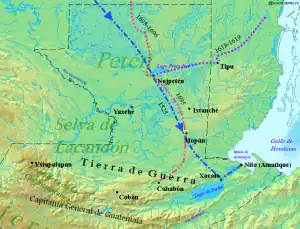 Spanish entry routes to Petén during the 17th century, overlaid with the route that Hernán Cortés took in 1525
Spanish entry routes to Petén during the 17th century, overlaid with the route that Hernán Cortés took in 1525
The Spanish conquest of Petén was the last stage of the conquest of Guatemala, a prolonged conflict during the Spanish colonisation of the Americas. A wide lowland plain covered with dense rainforest, Petén contains a central drainage basin with a series of lakes and areas of savannah. It is crossed by several ranges of low karstic hills and rises to the south as it nears the Guatemalan Highlands. The conquest of Petén, a region now incorporated into the modern republic of Guatemala, climaxed in 1697 with the capture of Nojpetén, the island capital of the Itza kingdom, by Martín de Ursúa y Arizmendi. With the defeat of the Itza, the last independent and unconquered native kingdom in the Americas fell to European colonisers. (Full article...) Image 18
Image 18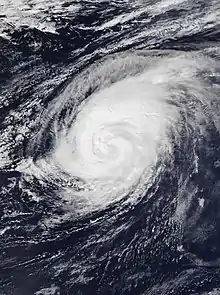 Hurricane Leslie near peak intensity southwest of the Azores on 11 October
Hurricane Leslie near peak intensity southwest of the Azores on 11 October
Hurricane Leslie (known as Storm Leslie or Cyclone Leslie), while extratropical, was the strongest cyclone of tropical origin to strike the Iberian Peninsula since 1842. A large, long-lived, and very erratic tropical cyclone, Leslie was the twelfth named storm and sixth hurricane of the 2018 Atlantic hurricane season.[1] The storm had a non-tropical origin, developing from an extratropical cyclone that was situated over the northern Atlantic on 22 September. The low quickly acquired subtropical characteristics and was classified as Subtropical Storm Leslie on the following day. The cyclone meandered over the northern Atlantic and gradually weakened, before merging with a frontal system on 25 September, which later intensified into a powerful hurricane-force extratropical low over the northern Atlantic. (Full article...) Image 19
Image 19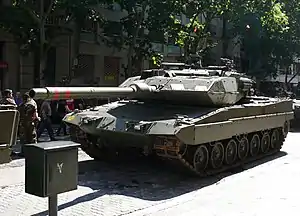 Spanish Leopard 2E in Zaragoza, June 2008
Spanish Leopard 2E in Zaragoza, June 2008
The Leopardo 2E or Leopard 2A6E (E stands for España (Spanish for 'Spain')) is a variant of the German Leopard 2 main battle tank (specifically the Leopard 2A6 variant), tailored to the requirements of the Spanish army, which acquired it as part of an armament modernization program named Programa Coraza, or Program Cuirass. The acquisition program for the Leopard 2E began in 1994, five years after the cancellation of the Lince tank program that culminated in an agreement to transfer 108 Leopard 2A4s to the Spanish army in 1998 and started the local production of the Leopard 2E in December 2002. Despite postponement of production owing to the 2003 merger between Santa Bárbara Sistemas and General Dynamics, and continued manufacturing issues between 2006 and 2007, 219 Leopard 2Es have been delivered to the Spanish army. (Full article...) Image 20
Image 20.jpg.webp) Witches' Sabbath, 1821–1823. Oil on plaster wall, transferred to canvas; 140.5 × 435.7 cm (56 × 172 in). Museo del Prado, Madrid
Witches' Sabbath, 1821–1823. Oil on plaster wall, transferred to canvas; 140.5 × 435.7 cm (56 × 172 in). Museo del Prado, Madrid
Witches' Sabbath or The Great He-Goat (Spanish: Aquelarre or El gran cabrón) are names given to an oil mural by the Spanish artist Francisco Goya, completed sometime between 1821 and 1823. It explores themes of violence, intimidation, aging and death. Satan hulks, in the form of a goat, in moonlit silhouette over a coven of terrified witches. Goya was then around 75 years old, living alone and suffering from acute mental and physical distress. (Full article...) Image 21
Image 21.png.webp) Lombardy in 1522. The location of the battle is marked.
Lombardy in 1522. The location of the battle is marked.
The Battle of Bicocca or La Bicocca (Italian: Battaglia della Bicocca) was fought on 27 April 1522, during the Italian War of 1521–26. A combined French and Venetian force under Odet de Foix, Vicomte de Lautrec, was decisively defeated by an Imperial–Spanish and Papal army under the overall command of Prospero Colonna. Lautrec then withdrew from Lombardy, leaving the Duchy of Milan in Imperial hands. (Full article...)![Image 22The Lince (Spanish pronunciation: [ˈlinθe], meaning "Lynx") was a Spanish development programme for a proposed main battle tank that unfolded during the late 1980s and early 1990s. The intention was to replace the M47 and M48 Patton tanks that the Spanish Army had received under the U.S. Mutual Defense Assistance Act between 1954 and 1975, and to complement the AMX-30E tanks manufactured for the army during the 1970s. Companies from several nations, such as German Krauss-Maffei, Spanish Santa Bárbara, and French GIAT, made bids for the development contract. The main priorities were mobility and firepower, with secondary priority placed on protection; the Lince tank was to have been lighter and faster than its competitors. To achieve a sufficient level of firepower and protection, the Lince was to use Rheinmetall's 120 mm L/44 tank-gun and German composite armour from the Leopard 2A4. (Full article...)](../I/Blank.png.webp) Image 22The Lince (Spanish pronunciation: [ˈlinθe], meaning "Lynx") was a Spanish development programme for a proposed main battle tank that unfolded during the late 1980s and early 1990s. The intention was to replace the M47 and M48 Patton tanks that the Spanish Army had received under the U.S. Mutual Defense Assistance Act between 1954 and 1975, and to complement the AMX-30E tanks manufactured for the army during the 1970s. Companies from several nations, such as German Krauss-Maffei, Spanish Santa Bárbara, and French GIAT, made bids for the development contract. The main priorities were mobility and firepower, with secondary priority placed on protection; the Lince tank was to have been lighter and faster than its competitors. To achieve a sufficient level of firepower and protection, the Lince was to use Rheinmetall's 120 mm L/44 tank-gun and German composite armour from the Leopard 2A4. (Full article...)
Image 22The Lince (Spanish pronunciation: [ˈlinθe], meaning "Lynx") was a Spanish development programme for a proposed main battle tank that unfolded during the late 1980s and early 1990s. The intention was to replace the M47 and M48 Patton tanks that the Spanish Army had received under the U.S. Mutual Defense Assistance Act between 1954 and 1975, and to complement the AMX-30E tanks manufactured for the army during the 1970s. Companies from several nations, such as German Krauss-Maffei, Spanish Santa Bárbara, and French GIAT, made bids for the development contract. The main priorities were mobility and firepower, with secondary priority placed on protection; the Lince tank was to have been lighter and faster than its competitors. To achieve a sufficient level of firepower and protection, the Lince was to use Rheinmetall's 120 mm L/44 tank-gun and German composite armour from the Leopard 2A4. (Full article...) Image 23Abu Abdullah Muhammad ibn Ismail (Arabic: أبو عبد الله محمد الرابع), known as Muhammad IV, (14 April 1315 – 25 August 1333) was the ruler of the Emirate of Granada on the Iberian Peninsula from 1325 to 1333. He was the sixth sultan of the Nasrid dynasty, succeeding to the throne at ten years old when his father, Ismail I (r. 1314–1325), was assassinated. (Full article...)
Image 23Abu Abdullah Muhammad ibn Ismail (Arabic: أبو عبد الله محمد الرابع), known as Muhammad IV, (14 April 1315 – 25 August 1333) was the ruler of the Emirate of Granada on the Iberian Peninsula from 1325 to 1333. He was the sixth sultan of the Nasrid dynasty, succeeding to the throne at ten years old when his father, Ismail I (r. 1314–1325), was assassinated. (Full article...) Image 24
Image 24 Map of the 2015 Vuelta a España route, from Marbella to Madrid.
Map of the 2015 Vuelta a España route, from Marbella to Madrid.
(stage courses in red)
The 2015 Vuelta a España was a three-week Grand Tour cycling race. The race was the 70th edition of the Vuelta a España and took place principally in Spain, although two stages took place partly or wholly in Andorra, and was the 22nd race in the 2015 UCI World Tour. The 3,358.1-kilometre (2,086.6 mi) race included 21 stages, beginning in Marbella on 22 August 2015 and finishing in Madrid on 13 September. It was won by Fabio Aru (Astana Pro Team), with Joaquim Rodríguez (Team Katusha) second and Rafał Majka (Tinkoff–Saxo) third. (Full article...) Image 25
Image 25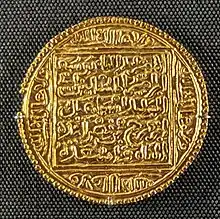 Dinar minted in Yusuf I's name
Dinar minted in Yusuf I's name
Abu al-Hajjaj Yusuf ibn Ismail (Arabic: أبو الحجاج يوسف بن إسماعيل; 29 June 1318 – 19 October 1354), known by the regnal name al-Muayyad billah (المؤيد بالله, "He who is aided by God"), was the seventh Nasrid ruler of the Emirate of Granada on the Iberian Peninsula. The third son of Ismail I (r. 1314–1322), he was Sultan between 1333 and 1354, after his brother Muhammad IV (r. 1325–1333) was assassinated. (Full article...)
Selected biography
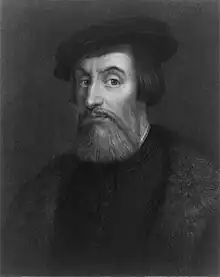
Hernán Cortés (also known as Hernán(do) Cortés Pizarro, 1st Marqués del Valle de Oaxaca; born 1485–December 2, 1547) was a Spanish conquistador who initiated the conquest of the Aztec Empire on behalf of Charles V, king of Castile and Holy Roman Emperor, in the early 16th century. Cortés was part of the generation of Spanish colonizers that began the first phase of the Spanish colonization of the Americas.[2]
Born in Medellín, Extremadura, in Castile, to a family of lesser nobility, Cortés chose to pursue a livelihood in the New World. He went to Hispaniola and later to Cuba, where he received an encomienda and, for a short time, became alcalde (mayor) of a small town. In 1519, he was elected captain of the third expedition to the mainland, an expedition which he partly funded. His enmity with the governor of Cuba, Diego Velázquez de Cuéllar, resulted in the latter recalling the expedition at the last moment, an order which Cortés ignored. Arriving on the continent, Cortés executed a successful strategy of allying with some indigenous peoples against others. He also used a native woman, Doña Marina, as interpreter; she would later bear Cortés a son. When the Governor of Cuba sent emissaries to arrest Cortés, he fought them and won, using the extra troops as reinforcements. Cortés wrote letters directly to the king asking to be acknowledged for his successes instead of punished for mutiny. After he overthrew the Aztec empire, Cortés was awarded the title of Marqués del Valle de Oaxaca, while the more prestigious title of Viceroy was given to a high-ranking nobleman, Antonio de Mendoza. Cortés returned to Spain in 1541 where he died peacefully but embittered.
Selected picture
 Image 1Photograph: Diego DelsoThe Assut de l'Or Bridge is a white single-pylon cable-stayed bridge in the City of Arts and Sciences, Valencia, Spain. Completed in 2008, it was designed by Valencian architect and civil engineer Santiago Calatrava as a variant of his cantilever spar cable-stayed bridge in Seville.
Image 1Photograph: Diego DelsoThe Assut de l'Or Bridge is a white single-pylon cable-stayed bridge in the City of Arts and Sciences, Valencia, Spain. Completed in 2008, it was designed by Valencian architect and civil engineer Santiago Calatrava as a variant of his cantilever spar cable-stayed bridge in Seville. Image 2
Image 2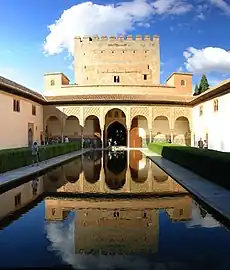 AlhambraCredit: Ra-smit
AlhambraCredit: Ra-smit
The Alhambra (Arabic: الحمراء = Al-Ħamrā; literally "the red") is a palace and fortress complex of the Moorish monarchs of Granada in southern Spain (known as Al-Andalus when the fortress was constructed), occupying a hilly terrace on the southeastern border of the city of Granada.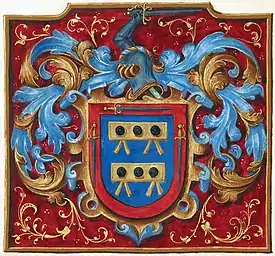 Image 3Image: Royal Household of Spain; Restoration: Lise BroerA Grant of Arms by Philip II of Spain to Alonso de Mesa and Hernando de Mesa, signed 25 November 1566. In Spanish heraldry, coats of arms were granted based almost entirely on military service, which made it possible for commoners to join the ranks of the Spanish nobility. Also unique to Spain was that titles could be inherited through females and via illegitimacy.
Image 3Image: Royal Household of Spain; Restoration: Lise BroerA Grant of Arms by Philip II of Spain to Alonso de Mesa and Hernando de Mesa, signed 25 November 1566. In Spanish heraldry, coats of arms were granted based almost entirely on military service, which made it possible for commoners to join the ranks of the Spanish nobility. Also unique to Spain was that titles could be inherited through females and via illegitimacy.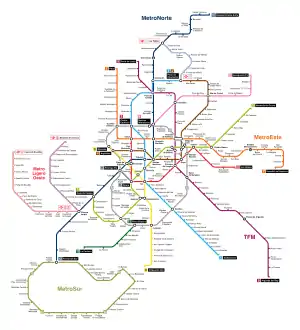 Image 4Map: JavitomadThe Madrid Metro is a rapid transit system serving the Spanish capital, Madrid. It was inaugurated in 1919 by King Alfonso, with a single line which ran for 3.48 km (2.16 mi) between Puerta del Sol and Cuatro Caminos, with eight stops. The present system has 301 stations on 13 lines plus one branch line, totalling 294 km (183 mi).
Image 4Map: JavitomadThe Madrid Metro is a rapid transit system serving the Spanish capital, Madrid. It was inaugurated in 1919 by King Alfonso, with a single line which ran for 3.48 km (2.16 mi) between Puerta del Sol and Cuatro Caminos, with eight stops. The present system has 301 stations on 13 lines plus one branch line, totalling 294 km (183 mi). Image 5
Image 5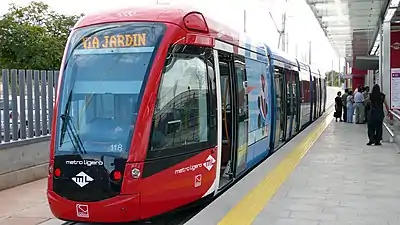 A light metro trainCredit: FDV
A light metro trainCredit: FDV
A metro light train currently in operation with Madrid Metro. This train is pictured on line ML2 at Aravaca metro station. Image 6
Image 6 Timanfaya National ParkCredit: Yummifruitbat
Timanfaya National ParkCredit: Yummifruitbat
Timanfaya National Park (Spanish: Parque Nacional de Timanfaya) is a national park, covering the southern area of Tinajo, Las Palmas and the northern area of Yaiza, Las Palmas. The parkland is made up of volcanic soil, with the strongest recorded eruptions occurring between 1730 and 1736..jpg.webp) Image 7Painting: Marià FortunyThe Spanish Wedding is an oil on panel painting by Marià Fortuny completed over a two-year period ending in 1870. It depicts the signing of a wedding contract in 18th century Spain and was influenced heavily by the works of Francisco Goya, whom the artist admired. It is currently exhibited at the National Art Museum of Catalonia.
Image 7Painting: Marià FortunyThe Spanish Wedding is an oil on panel painting by Marià Fortuny completed over a two-year period ending in 1870. It depicts the signing of a wedding contract in 18th century Spain and was influenced heavily by the works of Francisco Goya, whom the artist admired. It is currently exhibited at the National Art Museum of Catalonia.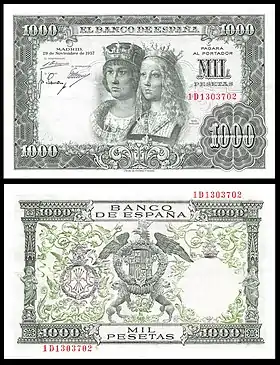 Image 8Banknote: Bank of SpainThe Spanish peseta is a former currency of Spain and, alongside the French franc, a former de facto currency in Andorra. It was introduced in 1868, replacing the peso, at a time when Spain was considering joining the Latin Monetary Union. Spain joined the euro in 1999, and the peseta was replaced by euro notes and coins in 2002.
Image 8Banknote: Bank of SpainThe Spanish peseta is a former currency of Spain and, alongside the French franc, a former de facto currency in Andorra. It was introduced in 1868, replacing the peso, at a time when Spain was considering joining the Latin Monetary Union. Spain joined the euro in 1999, and the peseta was replaced by euro notes and coins in 2002.
This picture shows a 1000 peseta banknote from 1957. The obverse depicts the Catholic Monarchs while the reverse shows the coat of arms of Spain. Image 9Photo credit: DiliffA stitched panorama taken from St Jerome, the summit of Montserrat, a 1,236 m (4,055 ft) mountain near Barcelona, Spain. The mountain's name means "jagged mountain" and is used because of the peculiar aspect of the formation, which is visible from a great distance.
Image 9Photo credit: DiliffA stitched panorama taken from St Jerome, the summit of Montserrat, a 1,236 m (4,055 ft) mountain near Barcelona, Spain. The mountain's name means "jagged mountain" and is used because of the peculiar aspect of the formation, which is visible from a great distance. Image 10Photo credit: David IliffThe Casa Milà, a 1912 work by Catalán architect Antoni Gaudi, in the Eixample district of Barcelona, Spain. Gaudí's fascination with trencadís-influenced decoration and curves (predating biomorphism by almost 20 years) can be seen here.
Image 10Photo credit: David IliffThe Casa Milà, a 1912 work by Catalán architect Antoni Gaudi, in the Eixample district of Barcelona, Spain. Gaudí's fascination with trencadís-influenced decoration and curves (predating biomorphism by almost 20 years) can be seen here.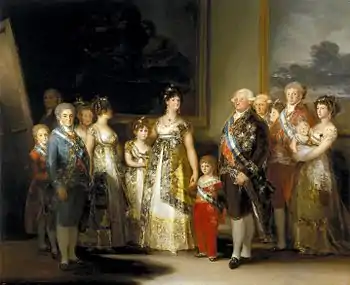 Image 11Painting credit: Francisco GoyaCharles IV of Spain and His Family is a portrait of the royal family of Spain painted by Francisco Goya in 1800 and 1801. King Charles IV, his wife Maria Luisa of Parma, and his children and relatives are dressed in the height of contemporary fashion, lavishly adorned with jewelry and the sashes of the order of Charles III. The artist does not attempt to flatter the family; instead the group portrait is unflinchingly realist, both in detail and tone. The artist, seated at his easel, is visible in the background. The painting is in the collection of the Museo del Prado in Madrid.
Image 11Painting credit: Francisco GoyaCharles IV of Spain and His Family is a portrait of the royal family of Spain painted by Francisco Goya in 1800 and 1801. King Charles IV, his wife Maria Luisa of Parma, and his children and relatives are dressed in the height of contemporary fashion, lavishly adorned with jewelry and the sashes of the order of Charles III. The artist does not attempt to flatter the family; instead the group portrait is unflinchingly realist, both in detail and tone. The artist, seated at his easel, is visible in the background. The painting is in the collection of the Museo del Prado in Madrid.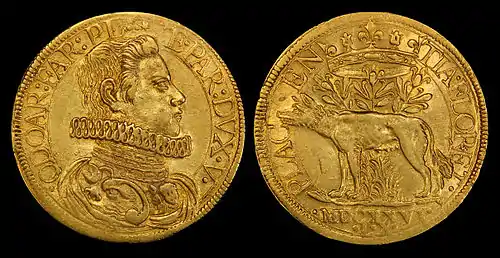 Image 12Coin design credit: Duchy of ParmaThe doubloon was a Spanish gold coin worth two escudos or 32 reales weighing 6.867 grams (0.221 troy ounces), introduced in 1537. It became the model for several other gold coins issued in Europe, including this 1626 two-doppie gold coin issued in Piacenza in northern Italy by the Duchy of Parma, depicting Odoardo Farnese, Duke of Parma, on the obverse. The coin is part of the National Numismatic Collection at the National Museum of American History.
Image 12Coin design credit: Duchy of ParmaThe doubloon was a Spanish gold coin worth two escudos or 32 reales weighing 6.867 grams (0.221 troy ounces), introduced in 1537. It became the model for several other gold coins issued in Europe, including this 1626 two-doppie gold coin issued in Piacenza in northern Italy by the Duchy of Parma, depicting Odoardo Farnese, Duke of Parma, on the obverse. The coin is part of the National Numismatic Collection at the National Museum of American History.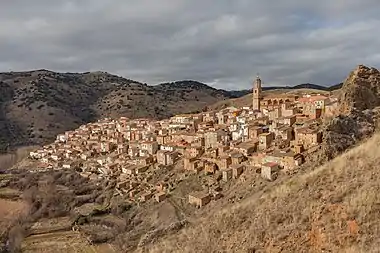 Image 13Photograph: Diego DelsoMoros is a municipality in the province of Zaragoza, Spain. Located in the Sistema Ibérico mountain range, the village lies on a hill, with the church and former town hall at the top, the residences in the middle, and the sheep pens at the bottom. The population of Moros has been steadily decreasing in recent decades, and was 478 in 2006.
Image 13Photograph: Diego DelsoMoros is a municipality in the province of Zaragoza, Spain. Located in the Sistema Ibérico mountain range, the village lies on a hill, with the church and former town hall at the top, the residences in the middle, and the sheep pens at the bottom. The population of Moros has been steadily decreasing in recent decades, and was 478 in 2006. Image 14Photo credit: DiliffThe Torre Agbar is a landmark skyscraper and the third tallest building in Barcelona, Spain. It was designed by French architect Jean Nouvel, who stated that the shape of the Torre Agbar was inspired by the mountains of Montserrat that surround Barcelona, and by the shape of a geyser of water rising into the air. Its design combines a number of different architectural concepts, resulting in a striking structure built with reinforced concrete, covered with a facade of glass, and over 4,500 window openings cut out of the structural concrete.
Image 14Photo credit: DiliffThe Torre Agbar is a landmark skyscraper and the third tallest building in Barcelona, Spain. It was designed by French architect Jean Nouvel, who stated that the shape of the Torre Agbar was inspired by the mountains of Montserrat that surround Barcelona, and by the shape of a geyser of water rising into the air. Its design combines a number of different architectural concepts, resulting in a striking structure built with reinforced concrete, covered with a facade of glass, and over 4,500 window openings cut out of the structural concrete. Image 15
Image 15.jpg.webp) The Puente Nuevo
The Puente Nuevo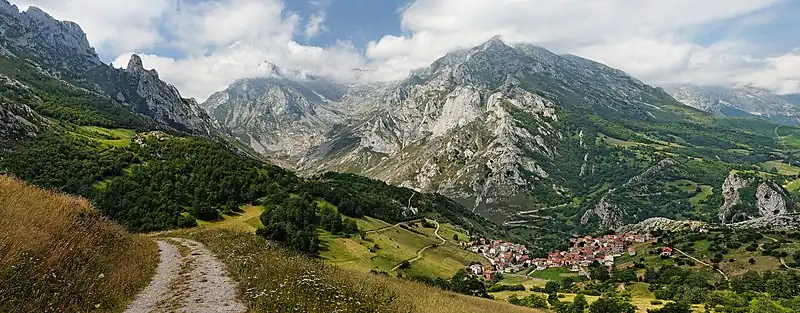 Image 16Photo: Mick StephensonThe peaks of the Central Massif overlook the village of Sotres in Cabrales, located in the Picos de Europa, a mountain range in northern Spain forming part of the Cantabrian Mountains. The name (literally: "Peaks of Europe") is believed to derive from being the first European landforms visible to mariners arriving from the Americas.
Image 16Photo: Mick StephensonThe peaks of the Central Massif overlook the village of Sotres in Cabrales, located in the Picos de Europa, a mountain range in northern Spain forming part of the Cantabrian Mountains. The name (literally: "Peaks of Europe") is believed to derive from being the first European landforms visible to mariners arriving from the Americas. Image 17
Image 17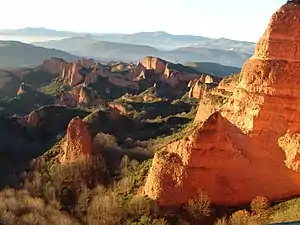 Las Médulas mine.Credit: Rayet
Las Médulas mine.Credit: Rayet
Las Médulas, located near the town of Ponferrada in León province, Spain, used to be the most important gold mine in the Roman Empire. Las Médulas Cultural Landscape is listed by the UNESCO as one of the World Heritage Sites.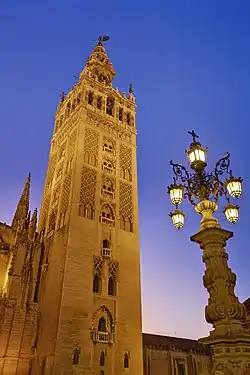 Image 18Photo: David IliffThe Giralda is a 104.5 m (343 ft) tall bell tower for the Seville Cathedral in Seville, Andalusia, Spain. It was originally constructed as a minaret in 1198, when Seville was ruled by the Almohad Caliphate. After the city was taken by the Christians in the Reconquista, the city's mosque was converted to a church. The upper third of the structure was completed during the Spanish Renaissance.
Image 18Photo: David IliffThe Giralda is a 104.5 m (343 ft) tall bell tower for the Seville Cathedral in Seville, Andalusia, Spain. It was originally constructed as a minaret in 1198, when Seville was ruled by the Almohad Caliphate. After the city was taken by the Christians in the Reconquista, the city's mosque was converted to a church. The upper third of the structure was completed during the Spanish Renaissance. Image 19Painting: Francisco GoyaThe Third of May 1808 is a painting completed in 1814 by the Spanish master Francisco Goya, now in the Museo del Prado, Madrid. Along with its companion piece of the same size, The Second of May 1808 (or The Charge of the Mamelukes), it was commissioned by the provisional government of Spain at Goya's suggestion. Goya sought to commemorate Spanish resistance to Napoleon's armies during the Peninsular War.
Image 19Painting: Francisco GoyaThe Third of May 1808 is a painting completed in 1814 by the Spanish master Francisco Goya, now in the Museo del Prado, Madrid. Along with its companion piece of the same size, The Second of May 1808 (or The Charge of the Mamelukes), it was commissioned by the provisional government of Spain at Goya's suggestion. Goya sought to commemorate Spanish resistance to Napoleon's armies during the Peninsular War. Image 20
Image 20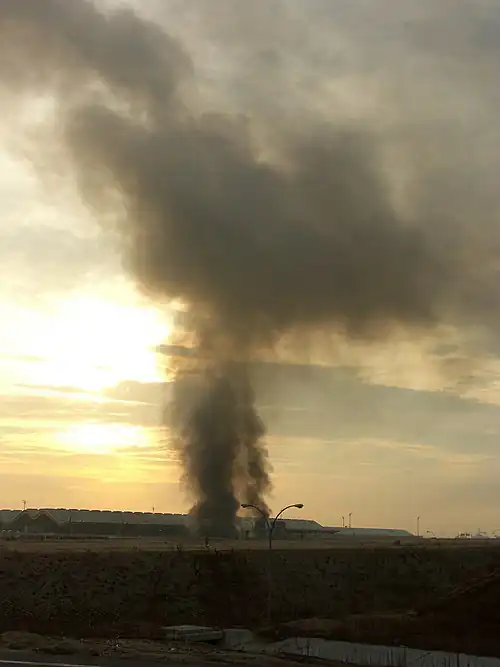 A distant shot of smoke coming from Madrid Barajas International Airport.Smoke coming from Madrid Barajas International Airport after the 2006 Madrid Barajas International Airport bombing. The terrorist incident occurred on the morning of December 30, 2006, when an explosion took place in the carpark building attached to Terminal 4 of the airport.
A distant shot of smoke coming from Madrid Barajas International Airport.Smoke coming from Madrid Barajas International Airport after the 2006 Madrid Barajas International Airport bombing. The terrorist incident occurred on the morning of December 30, 2006, when an explosion took place in the carpark building attached to Terminal 4 of the airport. Image 21
Image 21 The Temple of Debod.The Temple of Debod is an ancient Egyptian temple which has been rebuilt in Madrid, Spain. The temple was built in southern Egypt, very close to the first cataract of the Nile and to the great religious center dedicated to the goddess Isis, in Philae.
The Temple of Debod.The Temple of Debod is an ancient Egyptian temple which has been rebuilt in Madrid, Spain. The temple was built in southern Egypt, very close to the first cataract of the Nile and to the great religious center dedicated to the goddess Isis, in Philae.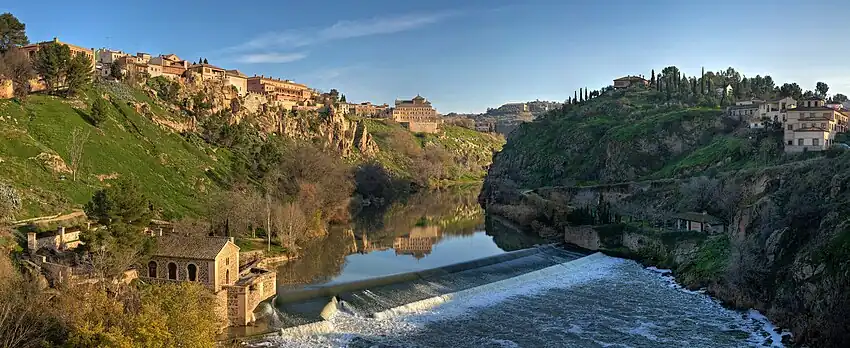 Image 22Photo credit: David IliffThe Tagus River, seen here passing through the World Heritage listed city of Toledo, Spain. It is the longest river on the Iberian Peninsula at 1,038 kilometres (645 mi). It begins its journey in the Albarracín mountains in Spain, and follows a very constricted course for much of its length before reaching the Atlantic Ocean in Portugal.
Image 22Photo credit: David IliffThe Tagus River, seen here passing through the World Heritage listed city of Toledo, Spain. It is the longest river on the Iberian Peninsula at 1,038 kilometres (645 mi). It begins its journey in the Albarracín mountains in Spain, and follows a very constricted course for much of its length before reaching the Atlantic Ocean in Portugal.
Did you know...
- ... that some people who are not Spanish citizens have the right to vote in elections for local public officials in the municipalities of Cantabria?
- ... that Jon Secada became the first black artist to top the Hot Latin Tracks chart in 1992, with the Spanish version of "Just Another Day"?
- ... that Spanish diplomat Ángel Sagaz Zubelzu secured the release of more than 1,500 Jews from prison in Egypt by arguing they were descended from expelled Jews and thus entitled to Spanish citizenship?
- ... that while other countries built monuments to José Rizal a century after his birth, the Rizal Monument in Madrid was built a century after his death?
- ... that Edward Glemham destroyed two Spanish vessels, repulsed four galleys, and captured a rich Venetian merchant ship in his first voyage as a privateer in 1590?
- ... that in 1991, Juan López Mella was the first Spanish rider to achieve a podium place in the Superbike World Championship?
 Good article –
Good article –
 Image 1Obras Son Amores is the third studio album by Spanish singer Antonio Carmona. It was released on March 31, 2017, through Universal Music Latin Entertainment. Carmona spent five years working with different artists on songs for the album. Alex Cuba, Claudia Brant, Juanes, Luis Enrique Mejía, and Alejandro Sanz, are some of the artists he collaborated with. (Full article...)
Image 1Obras Son Amores is the third studio album by Spanish singer Antonio Carmona. It was released on March 31, 2017, through Universal Music Latin Entertainment. Carmona spent five years working with different artists on songs for the album. Alex Cuba, Claudia Brant, Juanes, Luis Enrique Mejía, and Alejandro Sanz, are some of the artists he collaborated with. (Full article...) Image 2
Image 2 Indigenous ethnic groups of El Salvador, prior to Spanish conquest
Indigenous ethnic groups of El Salvador, prior to Spanish conquest
The Spanish conquest of El Salvador was the campaign undertaken by the Spanish conquistadores against the Late Postclassic Mesoamerican polities in the territory that is now incorporated into the modern Central American country of El Salvador. El Salvador is the smallest country in Central America, and is dominated by two mountain ranges running east–west. Its climate is tropical, and the year is divided into wet and dry seasons. Before the conquest the country formed a part of the Mesoamerican cultural region, and was inhabited by a number of indigenous peoples, including the Pipil, the Lenca, the Xinca, and Maya. Native weaponry consisted of spears, bows and arrows, and wooden swords with inset stone blades; they wore padded cotton armour. (Full article...) Image 3
Image 3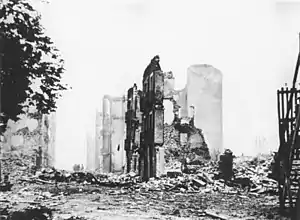 Aftermath of the aerial bombardment of Guernica
Aftermath of the aerial bombardment of Guernica
German involvement in the Spanish Civil War commenced with the outbreak of war in July 1936, with Adolf Hitler immediately sending in powerful air and armored units to assist General Francisco Franco and his Nationalist forces. The Soviet Union sent in smaller forces but a lot of modern weapons
to assist the Republican government, while Britain and France and two dozen other countries set up an embargo on any munitions or soldiers into Spain. Nazi Germany also signed the embargo, but simply ignored it. (Full article...) Image 4The background of the Spanish Civil War dates back to the end of the 19th century, when the owners of large estates, called latifundios, held most of the power in a land-based oligarchy. The landowners' power was unsuccessfully challenged by the industrial and merchant sectors. In 1868 popular uprisings led to the overthrow of Queen Isabella II of the House of Bourbon. In 1873 Isabella's replacement, King Amadeo I of the House of Savoy, abdicated due to increasing political pressure, and the short-lived First Spanish Republic was proclaimed. After the restoration of the Bourbons in December 1874, Carlists and anarchists emerged in opposition to the monarchy. Alejandro Lerroux helped bring republicanism to the fore in Catalonia, where poverty was particularly acute. Growing resentment of conscription and of the military culminated in the Tragic Week in Barcelona in 1909. After the First World War, the working class, the industrial class, and the military united in hopes of removing the corrupt central government, but were unsuccessful. Fears of communism grew. A military coup brought Miguel Primo de Rivera to power in 1923, and he ran Spain as a military dictatorship. Support for his regime gradually faded, and he resigned in January 1930. There was little support for the monarchy in the major cities, and King Alfonso XIII abdicated; the Second Spanish Republic was formed, whose power would remain until the culmination of the Spanish Civil War. Monarchists would continue to oppose the Republic. (Full article...)
Image 4The background of the Spanish Civil War dates back to the end of the 19th century, when the owners of large estates, called latifundios, held most of the power in a land-based oligarchy. The landowners' power was unsuccessfully challenged by the industrial and merchant sectors. In 1868 popular uprisings led to the overthrow of Queen Isabella II of the House of Bourbon. In 1873 Isabella's replacement, King Amadeo I of the House of Savoy, abdicated due to increasing political pressure, and the short-lived First Spanish Republic was proclaimed. After the restoration of the Bourbons in December 1874, Carlists and anarchists emerged in opposition to the monarchy. Alejandro Lerroux helped bring republicanism to the fore in Catalonia, where poverty was particularly acute. Growing resentment of conscription and of the military culminated in the Tragic Week in Barcelona in 1909. After the First World War, the working class, the industrial class, and the military united in hopes of removing the corrupt central government, but were unsuccessful. Fears of communism grew. A military coup brought Miguel Primo de Rivera to power in 1923, and he ran Spain as a military dictatorship. Support for his regime gradually faded, and he resigned in January 1930. There was little support for the monarchy in the major cities, and King Alfonso XIII abdicated; the Second Spanish Republic was formed, whose power would remain until the culmination of the Spanish Civil War. Monarchists would continue to oppose the Republic. (Full article...) Image 5"Agua Dulce, Agua Salá" ("Sweet Water, Salt Water") is a song from Spanish singer Julio Iglesias's studio album La Carretera (1995). The song was written by Estéfano, Donato Poveda, and Hal Batt and produced by Ramón Arcusa. It was released as the lead single from the album in 1995. A rumba flamenca, the song deals with the theme of life. The song received positive reactions from music critics, mostly being found catchy by them. It was a recipient of the ASCAP Latin Award in 1996. Commercially, the song peaked at number three on the Hot Latin Songs chart and number one on the Latin Pop Airplay chart in the United States. A music video for the song was filmed in Spain and features Fabiola Martinez. Iglesias also recorded it in Portuguese as "Água Doce, Água do Mar" for his studio album Ao Meu Brasil (2000). (Full article...)
Image 5"Agua Dulce, Agua Salá" ("Sweet Water, Salt Water") is a song from Spanish singer Julio Iglesias's studio album La Carretera (1995). The song was written by Estéfano, Donato Poveda, and Hal Batt and produced by Ramón Arcusa. It was released as the lead single from the album in 1995. A rumba flamenca, the song deals with the theme of life. The song received positive reactions from music critics, mostly being found catchy by them. It was a recipient of the ASCAP Latin Award in 1996. Commercially, the song peaked at number three on the Hot Latin Songs chart and number one on the Latin Pop Airplay chart in the United States. A music video for the song was filmed in Spain and features Fabiola Martinez. Iglesias also recorded it in Portuguese as "Água Doce, Água do Mar" for his studio album Ao Meu Brasil (2000). (Full article...) Image 6
Image 6
The Revolt of the Comuneros (Spanish: Guerra de las Comunidades de Castilla, "War of the Communities of Castile") was an uprising by citizens of Castile against the rule of Charles I and his administration between 1520 and 1521. At its height, the rebels controlled the heart of Castile, ruling the cities of Valladolid, Tordesillas, and Toledo. (Full article...)![Image 7Jesé playing for Paris Saint-Germain in 2019Jesé Rodríguez Ruiz (Spanish pronunciation: [xeˈse roˈðɾiɣeθ ˈrwiθ]; born 26 February 1993), known as Jesé, is a Spanish professional footballer who plays as winger or forward for Campeonato Brasileiro Série A club Coritiba. (Full article...)](../I/Blank.png.webp) Image 7
Image 7 Jesé playing for Paris Saint-Germain in 2019
Jesé playing for Paris Saint-Germain in 2019
Jesé Rodríguez Ruiz (Spanish pronunciation: [xeˈse roˈðɾiɣeθ ˈrwiθ]; born 26 February 1993), known as Jesé, is a Spanish professional footballer who plays as winger or forward for Campeonato Brasileiro Série A club Coritiba. (Full article...) Image 8Mauricio González-Gordon y Díez, Marquis of Bonanza (18 October 1923 – 27 September 2013) was a Spanish sherry maker and a conservationist. Most of his life he worked for the family company, González Byass, where he increased its exports to a worldwide level. His family estate was located in the wetland region called Doñana in southern Spain and was threatened by drainage efforts in the early 1950s. González-Gordon with the help of researchers and international support managed to preserve the site, while at the same time donating some of his family land to the conservation effort. Afterward, González-Gordon became one of the founders of the Spanish Ornithological Society in 1954. His conservation efforts for Doñana culminated in the creation of the Doñana National Park in 1969. The area was designated a UNESCO World Heritage Site in 1994. (Full article...)
Image 8Mauricio González-Gordon y Díez, Marquis of Bonanza (18 October 1923 – 27 September 2013) was a Spanish sherry maker and a conservationist. Most of his life he worked for the family company, González Byass, where he increased its exports to a worldwide level. His family estate was located in the wetland region called Doñana in southern Spain and was threatened by drainage efforts in the early 1950s. González-Gordon with the help of researchers and international support managed to preserve the site, while at the same time donating some of his family land to the conservation effort. Afterward, González-Gordon became one of the founders of the Spanish Ornithological Society in 1954. His conservation efforts for Doñana culminated in the creation of the Doñana National Park in 1969. The area was designated a UNESCO World Heritage Site in 1994. (Full article...) Image 9Spain in Our Hearts: Americans in the Spanish Civil War, 1936–1939 is a non-fiction book by Adam Hochschild that was first published by Houghton Mifflin Harcourt on March 29, 2016. The book is an account of the American volunteers who participated in the Spanish Civil War from 1936 to 1939. The story centers around several American volunteer fighters and journalists, tracing their motivations for joining the war and their experiences during the war which left many disillusioned. The book explains the involvement of foreign leaders including Adolf Hitler, Benito Mussolini and Joseph Stalin, and explains why the Republican faction ultimately lost. (Full article...)
Image 9Spain in Our Hearts: Americans in the Spanish Civil War, 1936–1939 is a non-fiction book by Adam Hochschild that was first published by Houghton Mifflin Harcourt on March 29, 2016. The book is an account of the American volunteers who participated in the Spanish Civil War from 1936 to 1939. The story centers around several American volunteer fighters and journalists, tracing their motivations for joining the war and their experiences during the war which left many disillusioned. The book explains the involvement of foreign leaders including Adolf Hitler, Benito Mussolini and Joseph Stalin, and explains why the Republican faction ultimately lost. (Full article...) Image 10
Image 10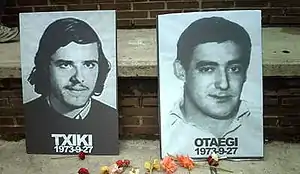 2011 memorial to two of those executed
2011 memorial to two of those executed
The last use of capital punishment in Spain took place on 27 September 1975 when two members of the armed Basque nationalist and separatist group ETA political-military and three members of the Revolutionary Antifascist Patriotic Front (FRAP) were executed by firing squads after having been convicted and sentenced to death by military tribunals for the murder of policemen and civil guards. Spain was Western Europe's only dictatorship at the time and had been unpopular and internationally isolated in the post-war period due to its relations with Nazi Germany in the 1930s and 1940s and the fact that its autocratic leader, Francisco Franco, had come to power by overthrowing a democratically elected government. As a result, the executions resulted in substantial criticism of the Spanish government, both domestically and abroad. Reactions included street protests, attacks on Spanish embassies, international criticism of the Spanish government and diplomatic measures, such as the withdrawal of the ambassadors of fifteen European countries. (Full article...)![Image 11Gasol with FC Barcelona in 2021Pau Gasol Sáez (Catalan: [ˈpaw ɣəˈzɔl], Spanish: [ˈpaw ɣaˈsol]; born July 6, 1980) is a Spanish former professional basketball player. He was a six-time NBA All-Star and a four-time All-NBA team selection, twice on the second team and twice on the third team. Gasol won two NBA championships, both with the Los Angeles Lakers back-to-back in 2009 and 2010. He was the NBA Rookie of the Year in 2002 with the Memphis Grizzlies, being the first non-American player to have won that award. He is regarded as one of the greatest power forwards of all time and is also considered as one of the greatest European players of all time. He is the older brother of former NBA player Marc Gasol. (Full article...)](../I/Blank.png.webp) Image 11
Image 11 Gasol with FC Barcelona in 2021
Gasol with FC Barcelona in 2021
Pau Gasol Sáez (Catalan: [ˈpaw ɣəˈzɔl], Spanish: [ˈpaw ɣaˈsol]; born July 6, 1980) is a Spanish former professional basketball player. He was a six-time NBA All-Star and a four-time All-NBA team selection, twice on the second team and twice on the third team. Gasol won two NBA championships, both with the Los Angeles Lakers back-to-back in 2009 and 2010. He was the NBA Rookie of the Year in 2002 with the Memphis Grizzlies, being the first non-American player to have won that award. He is regarded as one of the greatest power forwards of all time and is also considered as one of the greatest European players of all time. He is the older brother of former NBA player Marc Gasol. (Full article...) Image 12
Image 12
The 2008 Spanish Grand Prix (formally the Formula 1 Gran Premio de España Telefónica 2008) was a Formula One motor race held on 27 April 2008 at the Circuit de Catalunya, Montmeló, Spain. It was the fourth race of the 2008 Formula One World Championship. Kimi Räikkönen for the Ferrari team won the 66-lap race starting from pole position. Felipe Massa finished second in the other Ferrari, and Lewis Hamilton was third in a McLaren. (Full article...) Image 13Onneca Fortúnez or Iñiga Fortúnez (c. 848 – after 890) was a Basque princess from the Kingdom of Pamplona, later known as the Kingdom of Navarre. She was the daughter of Fortún Garcés of Pamplona and his wife Auria. At the time of Onneca's birth, which occurred between 848 and 850, the Iberian Peninsula was largely under the domination of the Muslim Umayyad dynasty. Only the northern kingdoms of Asturias, Pamplona and the Pyrenean threshold remained under control of Roman Catholic rulers. Onneca was a member of the Íñiguez dynasty, named after her great-grandfather Íñigo Arista, who founded the Kingdom of Pamplona. (Full article...)
Image 13Onneca Fortúnez or Iñiga Fortúnez (c. 848 – after 890) was a Basque princess from the Kingdom of Pamplona, later known as the Kingdom of Navarre. She was the daughter of Fortún Garcés of Pamplona and his wife Auria. At the time of Onneca's birth, which occurred between 848 and 850, the Iberian Peninsula was largely under the domination of the Muslim Umayyad dynasty. Only the northern kingdoms of Asturias, Pamplona and the Pyrenean threshold remained under control of Roman Catholic rulers. Onneca was a member of the Íñiguez dynasty, named after her great-grandfather Íñigo Arista, who founded the Kingdom of Pamplona. (Full article...) Image 14Spain participated in the Eurovision Song Contest 2013 with the song "Contigo hasta el final" written by Raquel del Rosario, David Feito and Juan Luis Suárez. The song was performed by the band ESDM, which was internally selected by the Spanish broadcaster Televisión Española (TVE) to represent Spain at the 2013 contest in Malmö, Sweden. ESDM was announced as the Spanish representative on 17 December 2012, while the national final El Sueño de Morfeo: Destino Eurovisión was organised in order to select the song ESDM would perform. Three songs, one selected through an Internet public vote, competed in the televised show where an in-studio jury and a public televote selected "Contigo hasta el final" as the winning song. (Full article...)
Image 14Spain participated in the Eurovision Song Contest 2013 with the song "Contigo hasta el final" written by Raquel del Rosario, David Feito and Juan Luis Suárez. The song was performed by the band ESDM, which was internally selected by the Spanish broadcaster Televisión Española (TVE) to represent Spain at the 2013 contest in Malmö, Sweden. ESDM was announced as the Spanish representative on 17 December 2012, while the national final El Sueño de Morfeo: Destino Eurovisión was organised in order to select the song ESDM would perform. Three songs, one selected through an Internet public vote, competed in the televised show where an in-studio jury and a public televote selected "Contigo hasta el final" as the winning song. (Full article...) Image 15
Image 15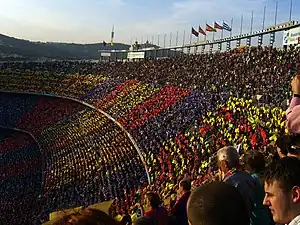 Barcelona supporters during a match at Camp Nou.
Barcelona supporters during a match at Camp Nou.
FC Barcelona is a professional multi-sports club based in Barcelona, formed in 1899 by a group of Swiss, Catalan, German and English footballers led by Joan Gamper. It has been part of the Spanish top-flight, La Liga, since the league's inception in 1928, winning it 27 times, along with a record 31 Copa del Rey and 5 UEFA Champions League victories. (Full article...)![Image 16Domínguez playing for Atlético Madrid in 2009Álvaro Domínguez Soto (Spanish pronunciation: [ˈalβaɾo ðoˈmiŋɡeθ ˈsoto]; born 16 May 1989) is a Spanish former professional footballer who played as a centre back and left back during the course of his career. (Full article...)](../I/Blank.png.webp) Image 16
Image 16.PNG.webp) Domínguez playing for Atlético Madrid in 2009
Domínguez playing for Atlético Madrid in 2009
Álvaro Domínguez Soto (Spanish pronunciation: [ˈalβaɾo ðoˈmiŋɡeθ ˈsoto]; born 16 May 1989) is a Spanish former professional footballer who played as a centre back and left back during the course of his career. (Full article...) Image 17
Image 17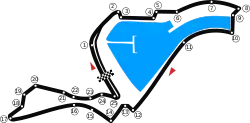 The Valencia Street Circuit
The Valencia Street Circuit
The 2010 European Grand Prix (formally the 2010 Formula 1 Telefónica Grand Prix of Europe) was a Formula One motor race held on 27 June at the Valencia Street Circuit in Valencia, Spain. It was the ninth round of the 2010 Formula One World Championship. Red Bull driver Sebastian Vettel won the 57-lap race from pole position. Lewis Hamilton finished second for the McLaren team and his teammate Jenson Button was third. It was Vettel's second win of the season, and the seventh of his Formula One career. (Full article...) Image 18The 1957 Latin Cup (Spanish: Copa Latina de 1957) was the eighth and final edition of the annual Latin Cup. It was contested by the domestic league champions the Southwest European nations of France, Italy, Portugal, and Spain. The clubs which competed in the tournament were AS Saint-Étienne, AC Milan, SL Benfica, and Real Madrid CF. (Full article...)
Image 18The 1957 Latin Cup (Spanish: Copa Latina de 1957) was the eighth and final edition of the annual Latin Cup. It was contested by the domestic league champions the Southwest European nations of France, Italy, Portugal, and Spain. The clubs which competed in the tournament were AS Saint-Étienne, AC Milan, SL Benfica, and Real Madrid CF. (Full article...) Image 19
Image 19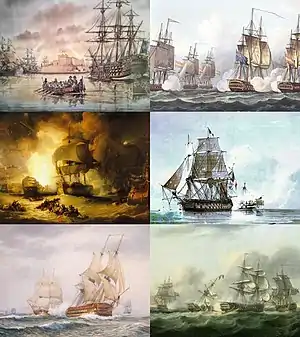 Mediterranean campaign of 1798Click an image to load the appropriate article.
Mediterranean campaign of 1798Click an image to load the appropriate article.
Left to right, top to bottom:
Battles of Malta, 15 July 1798, the Nile, 18 August 1798, the Malta Convoy, 31 March 1800
The Mediterranean campaign of 1798 was a series of major naval operations surrounding a French expeditionary force sent to Egypt under Napoleon Bonaparte during the French Revolutionary Wars. The French Republic sought to capture Egypt as the first stage in an effort to threaten British India and support Tipu Sultan, and thus force Great Britain to make peace. Departing Toulon in May 1798 with over 40,000 troops and hundreds of ships, Bonaparte's fleet sailed southeastwards across the Mediterranean Sea. They were followed by a small British squadron under Rear-Admiral Sir Horatio Nelson, later reinforced to 13 ships of the line, whose pursuit was hampered by a lack of scouting frigates and reliable information. Bonaparte's first target was the island of Malta, which was under the government of the Knights of St. John and theoretically granted its owner control of the Central Mediterranean. Bonaparte's forces landed on the island and rapidly overwhelmed the defenders, securing the port city of Valletta before continuing to Egypt. When Nelson learned of the French capture of the island, he guessed the French target to be Egypt and sailed for Alexandria, but passed the French during the night of 22 June without discovering them and arrived off Egypt first. (Full article...) Image 20
Image 20_-_Google_Art_Project.jpg.webp)
Tristan and Isolde (Spanish: Tristán e Isolda) is the title of two oil paintings by the Spanish artist Rogelio de Egusquiza. Both works are based on the opera Tristan und Isolde by the German composer Richard Wagner, whom Egusquiza idolised. The first painting, subtitled Death and also known as La mort d'Isolde (The Death of Isolde), was completed in 1910 and depicts Isolde's "Liebestod", as she collapses in death upon the lifeless body of Tristan. The second painting, subtitled Life, was completed two years later and depicts the lovers embracing in the night, a scene from the second act of Wagner's opera. (Full article...) Image 21The 2009 Palma Nova bombing occurred on July 30, 2009, when a limpet bomb went off outside a Civil Guard barracks in the town of Palma Nova, Majorca, Spain. The bomb was placed under a patrol car and two Civil Guard officers died as a result of the explosion. A second device was found under another Civil Guard vehicle at nearby barracks and safely exploded by police. On August 9, the Basque nationalist and separatist organisation ETA claimed responsibility for the attack, while four other bombs exploded around restaurants and shopping centres in Palma, Majorca, causing no injuries. (Full article...)
Image 21The 2009 Palma Nova bombing occurred on July 30, 2009, when a limpet bomb went off outside a Civil Guard barracks in the town of Palma Nova, Majorca, Spain. The bomb was placed under a patrol car and two Civil Guard officers died as a result of the explosion. A second device was found under another Civil Guard vehicle at nearby barracks and safely exploded by police. On August 9, the Basque nationalist and separatist organisation ETA claimed responsibility for the attack, while four other bombs exploded around restaurants and shopping centres in Palma, Majorca, causing no injuries. (Full article...)![Image 22Guardiola with Manchester City in 2017Josep "Pep" Guardiola Sala (Catalan pronunciation: [ˈpɛb ɡwəɾðiˈɔlə]; born 18 January 1971) is a Spanish professional football manager and former player who is currently managing Premier League club Manchester City. Guardiola is the only manager to win the continental treble twice, the youngest to win the UEFA Champions League, and he also holds the records for the most consecutive league games won in La Liga, the Bundesliga, and the Premier League. He is considered to be one of the greatest managers of all time. (Full article...)](../I/Blank.png.webp) Image 22
Image 22.jpg.webp) Guardiola with Manchester City in 2017
Guardiola with Manchester City in 2017
Josep "Pep" Guardiola Sala (Catalan pronunciation: [ˈpɛb ɡwəɾðiˈɔlə]; born 18 January 1971) is a Spanish professional football manager and former player who is currently managing Premier League club Manchester City. Guardiola is the only manager to win the continental treble twice, the youngest to win the UEFA Champions League, and he also holds the records for the most consecutive league games won in La Liga, the Bundesliga, and the Premier League. He is considered to be one of the greatest managers of all time. (Full article...) Image 23
Image 23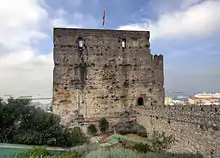 The Moorish Castle's Tower of Homage, the largest surviving remnant of Moorish Gibraltar. The dents in its eastern wall were caused by Castilian siege engines in 1333.
The Moorish Castle's Tower of Homage, the largest surviving remnant of Moorish Gibraltar. The dents in its eastern wall were caused by Castilian siege engines in 1333.
The history of Moorish Gibraltar began with the landing of the Muslims in Hispania and the fall of the Visigothic Kingdom of Toledo in 711 and ended with the fall of Gibraltar to Christian hands 751 years later, in 1462, with an interregnum during the early 14th century. (Full article...) Image 24
Image 24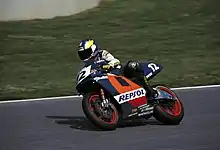 Juan López Mella, riding his Repsol ROC-Yamaha at the 1994 Italian Grand Prix
Juan López Mella, riding his Repsol ROC-Yamaha at the 1994 Italian Grand Prix
Juan Manuel López Mella (12 April 1965 – 10 May 1995) was a Spanish professional Grand Prix and Superbike motorcycle racer. After coming second in the national championships in 1985, he entered international competitions for the first time in 1987. He was the first person from Galicia to enter the competition. He came third in the 1991 Spanish Superbike race at Jarama, the first person from Spain to gain a podium position in the competition, and was named Spanish Superbike champion in both 1991 and 1992, becoming the highest placed private rider overall in 1993. In 1995, he started riding in the Thunderbike tournament but was killed in a road accident early in the season. Lugo, his city of birth, has named a park that teaches road safety in his honour and hosts a museum in his memory. (Full article...) Image 25Abd al-Malik ibn Umar ibn Marwan ibn al-Hakam (Arabic: عبد الملك ابن عمر بن مروان بن الحكم, romanized: ʿAbd al-Malik ibn ʿUmar ibn Marwān ibn al-Ḥakam; c. 718– c. 778), also known as al-Marwani, was an Umayyad prince, general and governor of Seville under the first Umayyad emir of al-Andalus (Islamic Spain), Abd al-Rahman I (r. 756–788). He led two major campaigns in 758 and 774, the first against the previous ruler of al-Andalus Yusuf ibn Abd al-Rahman al-Fihri and the second against the rebellious troops of Seville and Beja. His victories solidified the Umayyad emirate's control of western al-Andalus. His descendants continued to play important political and military roles in the Emirate well into the 10th century. (Full article...)
Image 25Abd al-Malik ibn Umar ibn Marwan ibn al-Hakam (Arabic: عبد الملك ابن عمر بن مروان بن الحكم, romanized: ʿAbd al-Malik ibn ʿUmar ibn Marwān ibn al-Ḥakam; c. 718– c. 778), also known as al-Marwani, was an Umayyad prince, general and governor of Seville under the first Umayyad emir of al-Andalus (Islamic Spain), Abd al-Rahman I (r. 756–788). He led two major campaigns in 758 and 774, the first against the previous ruler of al-Andalus Yusuf ibn Abd al-Rahman al-Fihri and the second against the rebellious troops of Seville and Beja. His victories solidified the Umayyad emirate's control of western al-Andalus. His descendants continued to play important political and military roles in the Emirate well into the 10th century. (Full article...)
General images
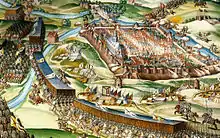
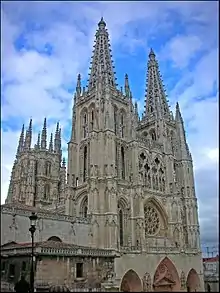
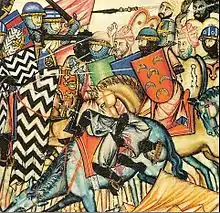
.svg.png.webp) Image 4Map of territories that were once part of the Spanish Empire (from History of Spain)
Image 4Map of territories that were once part of the Spanish Empire (from History of Spain) Image 5Celebrations of the proclamation of the 2nd Republic in Barcelona. (from History of Spain)
Image 5Celebrations of the proclamation of the 2nd Republic in Barcelona. (from History of Spain)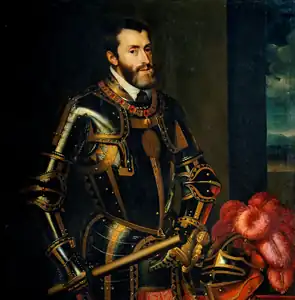 Image 6Charles I of Spain (better known in the English-speaking world as the Holy Roman Emperor Charles V) was the most powerful European monarch of his day. (from History of Spain)
Image 6Charles I of Spain (better known in the English-speaking world as the Holy Roman Emperor Charles V) was the most powerful European monarch of his day. (from History of Spain)
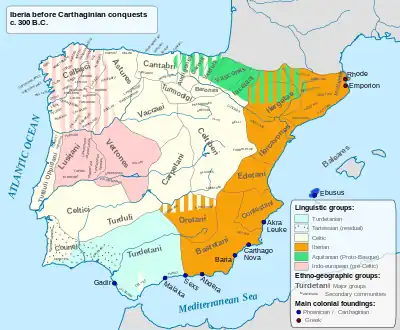 Image 8The Iberian Peninsula in the 3rd century BC (from History of Spain)
Image 8The Iberian Peninsula in the 3rd century BC (from History of Spain)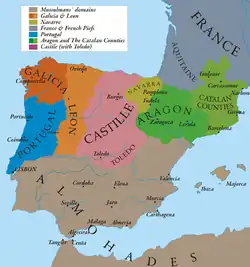 Image 9The Christian kingdoms of Hispania and the Islamic Almohad empire c. 1210
Image 9The Christian kingdoms of Hispania and the Islamic Almohad empire c. 1210.jpg.webp) Image 10El paseo de las Delicias, a 1784–1785 painting by Ramón Bayeu depicting a meeting of members of the aristocracy in the aforementioned location. (from History of Spain)
Image 10El paseo de las Delicias, a 1784–1785 painting by Ramón Bayeu depicting a meeting of members of the aristocracy in the aforementioned location. (from History of Spain)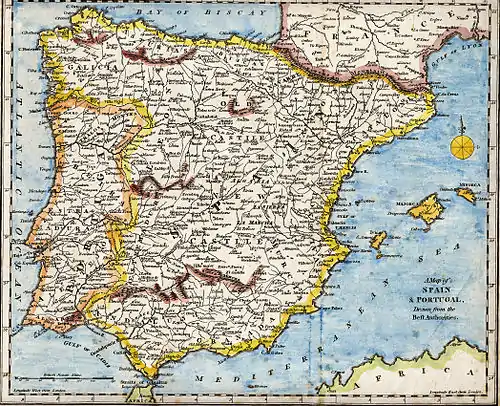
_en_Prins_Juan_Carlos%252C_Bestanddeelnr_254-9762.jpg.webp) Image 12Francisco Franco and his appointed successor Prince Juan Carlos de Borbón. (from History of Spain)
Image 12Francisco Franco and his appointed successor Prince Juan Carlos de Borbón. (from History of Spain)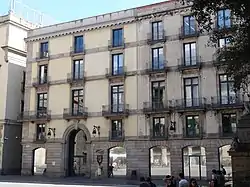
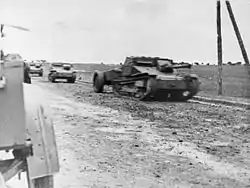
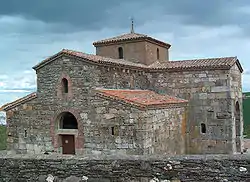 Image 15Visigothic church, San Pedro de la Nave. Zamora. Spain (from History of Spain)
Image 15Visigothic church, San Pedro de la Nave. Zamora. Spain (from History of Spain)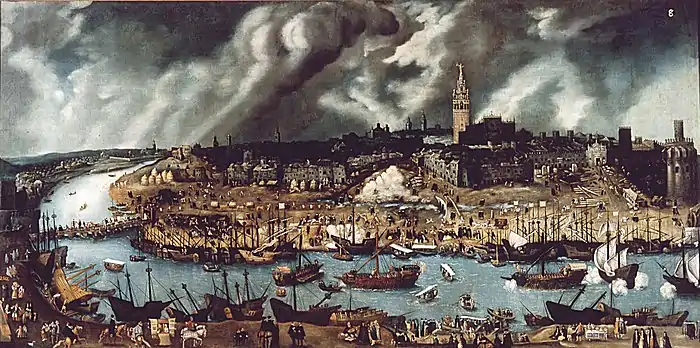 Image 16The Port of Seville in the late 16th century. Seville became one of the most populous and cosmopolitan European cities after the expeditions to the New World. (from History of Spain)
Image 16The Port of Seville in the late 16th century. Seville became one of the most populous and cosmopolitan European cities after the expeditions to the New World. (from History of Spain).jpg.webp)

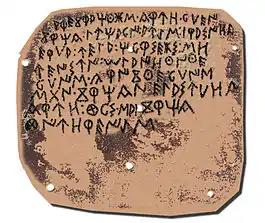 Image 19Illustration depicting the (now lost) Luzaga's Bronze, an example of the Celtiberian script. (from History of Spain)
Image 19Illustration depicting the (now lost) Luzaga's Bronze, an example of the Celtiberian script. (from History of Spain).jpg.webp) Image 20The pro-independence forces delivered a crushing defeat to the royalists and secured the independence of Peru in the 1824 battle of Ayacucho. (from History of Spain)
Image 20The pro-independence forces delivered a crushing defeat to the royalists and secured the independence of Peru in the 1824 battle of Ayacucho. (from History of Spain)![Image 21Detail of the votive crown of Recceswinth from the Treasure of Guarrazar, (Toledo-Spain) hanging in Madrid. The hanging letters spell [R]ECCESVINTHVS REX OFFERET [King R. offers this]. (from History of Spain)](../I/Corona_de_(29049230050).jpg.webp) Image 21Detail of the votive crown of Recceswinth from the Treasure of Guarrazar, (Toledo-Spain) hanging in Madrid. The hanging letters spell [R]ECCESVINTHVS REX OFFERET [King R. offers this]. (from History of Spain)
Image 21Detail of the votive crown of Recceswinth from the Treasure of Guarrazar, (Toledo-Spain) hanging in Madrid. The hanging letters spell [R]ECCESVINTHVS REX OFFERET [King R. offers this]. (from History of Spain)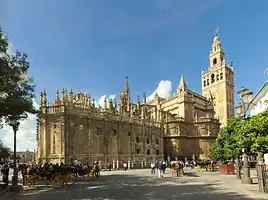
.jpg.webp) Image 23Christopher Columbus leads expedition to the New World, 1492, sponsored by Spanish crown (from History of Spain)
Image 23Christopher Columbus leads expedition to the New World, 1492, sponsored by Spanish crown (from History of Spain) Image 24Two women and a man during the siege of the Alcázar (from History of Spain)
Image 24Two women and a man during the siege of the Alcázar (from History of Spain)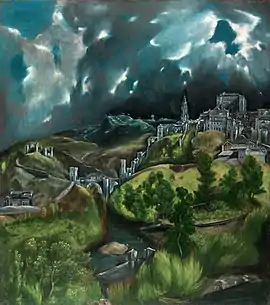
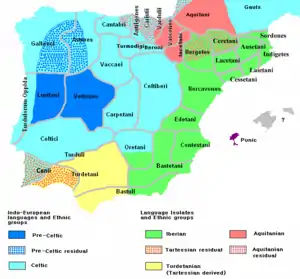 Image 26Ethnology of the Iberian Peninsula c. 200 BC (from History of Spain)
Image 26Ethnology of the Iberian Peninsula c. 200 BC (from History of Spain).JPG.webp) Image 27Episode of the 1854 Spanish Revolution in the Puerta del Sol, by Eugenio Lucas Velázquez. (from History of Spain)
Image 27Episode of the 1854 Spanish Revolution in the Puerta del Sol, by Eugenio Lucas Velázquez. (from History of Spain)
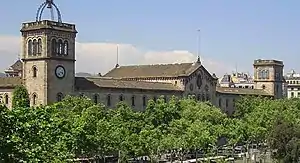
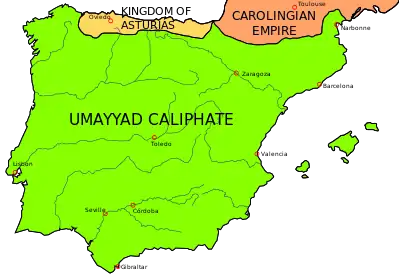
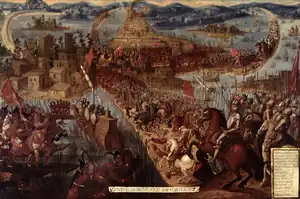 Image 31The Conquest of Tenochtitlán (from History of Spain)
Image 31The Conquest of Tenochtitlán (from History of Spain)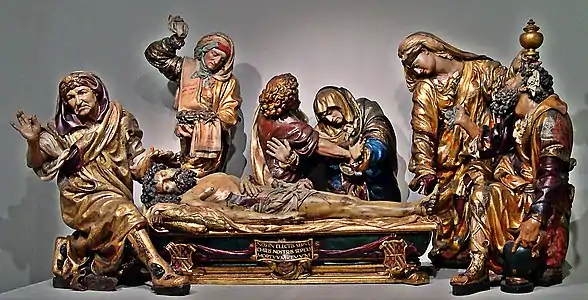
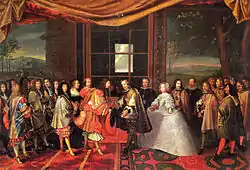 Image 33Louis XIV of France and Philip IV of Spain at the Meeting on the Isle of Pheasants in June 1660, part of the process to put an end to the Franco-Spanish War (1635–59). (from History of Spain)
Image 33Louis XIV of France and Philip IV of Spain at the Meeting on the Isle of Pheasants in June 1660, part of the process to put an end to the Franco-Spanish War (1635–59). (from History of Spain)_-_Fondo_Car-Kutxa_Fototeka.jpg.webp)
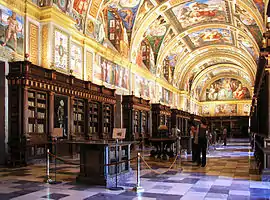
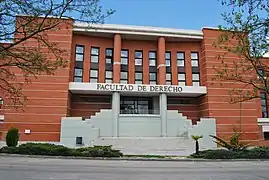
 Image 37Las Meninas (1656, English: The Maids of Honour) by Diego Velázquez (from Spanish Golden Age)
Image 37Las Meninas (1656, English: The Maids of Honour) by Diego Velázquez (from Spanish Golden Age)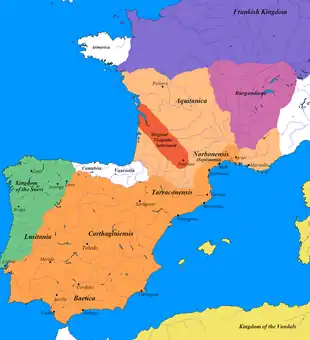 Image 38The greatest extent of the Visigothic Kingdom of Toulouse, c. 500, showing Territory lost after Vouillé in light orange (from History of Spain)
Image 38The greatest extent of the Visigothic Kingdom of Toulouse, c. 500, showing Territory lost after Vouillé in light orange (from History of Spain)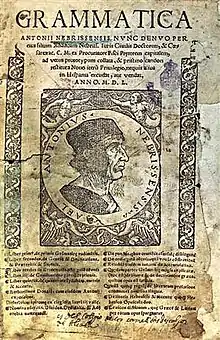 Image 39The title page of the Gramática de la lengua castellana (1492), the first grammar of a modern European language to be published. (from History of Spain)
Image 39The title page of the Gramática de la lengua castellana (1492), the first grammar of a modern European language to be published. (from History of Spain).jpg.webp) Image 40Execution of Torrijos and his men in 1831. Ferdinand VII took repressive measures against the liberal forces in his country. (from History of Spain)
Image 40Execution of Torrijos and his men in 1831. Ferdinand VII took repressive measures against the liberal forces in his country. (from History of Spain) Image 41The Second of May 1808 was the beginning of the popular Spanish resistance against Napoleon. (from History of Spain)
Image 41The Second of May 1808 was the beginning of the popular Spanish resistance against Napoleon. (from History of Spain)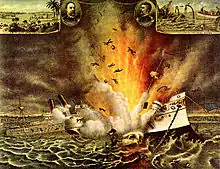 Image 42The explosion of the USS Maine launched the Spanish–American War in April 1898 (from History of Spain)
Image 42The explosion of the USS Maine launched the Spanish–American War in April 1898 (from History of Spain)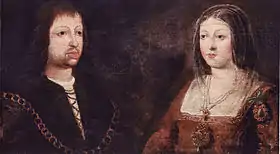 Image 43Wedding portrait of the Catholic Monarchs (from History of Spain)
Image 43Wedding portrait of the Catholic Monarchs (from History of Spain).jpg.webp) Image 44Visigothic King Roderic haranguing his troops before the Battle of Guadalete (from History of Spain)
Image 44Visigothic King Roderic haranguing his troops before the Battle of Guadalete (from History of Spain)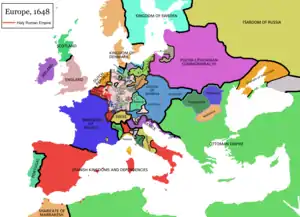
 Image 461894 satirical cartoon depicting the tacit accord for seamless government change (turnismo) between the leaders of two dynastic parties (Sagasta and Cánovas del Castillo), with the country being lied in an allegorical fashion. (from History of Spain)
Image 461894 satirical cartoon depicting the tacit accord for seamless government change (turnismo) between the leaders of two dynastic parties (Sagasta and Cánovas del Castillo), with the country being lied in an allegorical fashion. (from History of Spain)
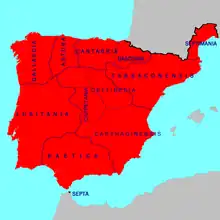 Image 48Visigothic Hispania and its regional divisions in 700, prior to the Muslim conquest (from History of Spain)
Image 48Visigothic Hispania and its regional divisions in 700, prior to the Muslim conquest (from History of Spain) Image 49People's militias attacking on a Rebel position in Somosierra in the early stages of the war. (from History of Spain)
Image 49People's militias attacking on a Rebel position in Somosierra in the early stages of the war. (from History of Spain) Image 50Proclamation of the Spanish Republic in Madrid (from History of Spain)
Image 50Proclamation of the Spanish Republic in Madrid (from History of Spain)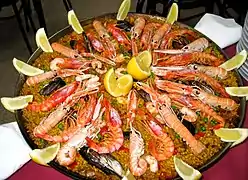
 Image 52Felipe González signing the treaty of accession to the European Economic Community on 12 June 1985. (from History of Spain)
Image 52Felipe González signing the treaty of accession to the European Economic Community on 12 June 1985. (from History of Spain)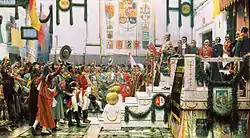 Image 53The promulgation of the Constitution of 1812, oil painting by Salvador Viniegra. (from History of Spain)
Image 53The promulgation of the Constitution of 1812, oil painting by Salvador Viniegra. (from History of Spain)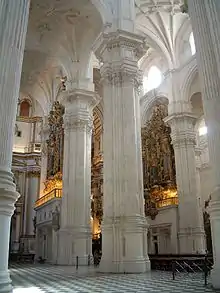
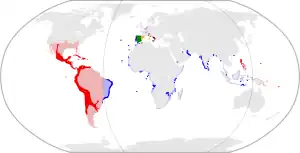
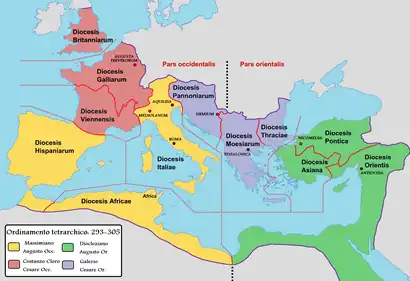
 Image 57Recognition of the Duke of Anjou as King of Spain, under the name of Philip V , November 16, 1700 (from History of Spain)
Image 57Recognition of the Duke of Anjou as King of Spain, under the name of Philip V , November 16, 1700 (from History of Spain)
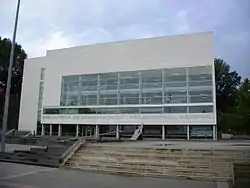

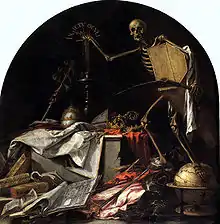 Image 61In ictu oculi ("In the blink of an eye"), a vanitas by Juan de Valdés Leal (from Spanish Golden Age)
Image 61In ictu oculi ("In the blink of an eye"), a vanitas by Juan de Valdés Leal (from Spanish Golden Age) Image 62The successful 1925 Alhucemas landing turned the luck in the Rif War towards Spain's favour. (from History of Spain)
Image 62The successful 1925 Alhucemas landing turned the luck in the Rif War towards Spain's favour. (from History of Spain)

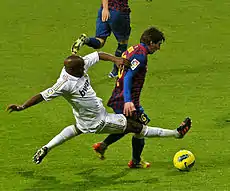
.jpg.webp) Image 66Members of the provisional government after the 1868 Glorious Revolution, by Jean Laurent. (from History of Spain)
Image 66Members of the provisional government after the 1868 Glorious Revolution, by Jean Laurent. (from History of Spain)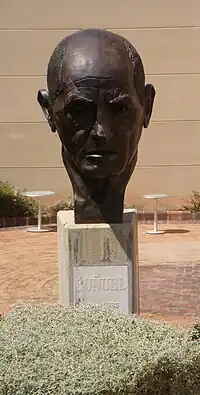 Image 67Cabeza de Luis Buñuel, sculptor's work by Iñaki, in the center Buñuel Calanda. (from Culture of Spain)
Image 67Cabeza de Luis Buñuel, sculptor's work by Iñaki, in the center Buñuel Calanda. (from Culture of Spain)
In the news
- 12 October 2023 – 2023 Israel–Hamas war protests
- Rallies in support of Palestine take place around the world, including in Argentina, Canada, Chile, Germany, Japan, South Africa, South Korea, and Spain. (DD News) (KTBS)
- 26 October 2023 – 2023 Israel–Hamas war protests
- Fans of Scotland's Celtic Football Club defy their club's directives and wave thousands of Palestinian flags during their team's Champions League match against Atlético Madrid. (Al Jazeera)
Spain topics
| History |
| ||||||
|---|---|---|---|---|---|---|---|
| Geography | |||||||
| Politics | |||||||
| Economy | |||||||
| Society |
| ||||||
Categories
WikiProjects
- Main project
WikiProject Spain
- Related projects
WikiProject Basque • WikiProject Catalan-speaking Countries • WikiProject Galicia • Spanish Translation of the Week
Things you can do

- Add {{WikiProject Spain}} to article talk pages which have some relation to Spain
- Help write new Spain-related articles and improve and expand existent ones
- Assess: unassessed Spain-related articles
- Suggest: selected articles, biographies, pictures, did you knows? and quotes for this Portal
Related portals
Associated Wikimedia
The following Wikimedia Foundation sister projects provide more on this subject:
-
 Commons
Commons
Free media repository -
 Wikibooks
Wikibooks
Free textbooks and manuals -
 Wikidata
Wikidata
Free knowledge base -
 Wikinews
Wikinews
Free-content news -
 Wikiquote
Wikiquote
Collection of quotations -
 Wikisource
Wikisource
Free-content library -
 Wikiversity
Wikiversity
Free learning tools -
 Wikivoyage
Wikivoyage
Free travel guide -
 Wiktionary
Wiktionary
Dictionary and thesaurus
-
 List of all portalsList of all portals
List of all portalsList of all portals -
 The arts portal
The arts portal -
 Biography portal
Biography portal -
 Current events portal
Current events portal -
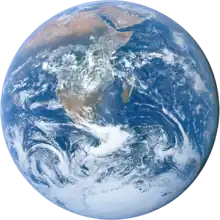 Geography portal
Geography portal -
 History portal
History portal -
 Mathematics portal
Mathematics portal -
 Science portal
Science portal -
 Society portal
Society portal -
 Technology portal
Technology portal -
 Random portalRandom portal
Random portalRandom portal -
 WikiProject PortalsWikiProject Portals
WikiProject PortalsWikiProject Portals
- "Atlantic hurricane best track (HURDAT version 2)" (Database). United States National Hurricane Center. April 5, 2023. Retrieved October 28, 2023.
 This article incorporates text from this source, which is in the public domain.
This article incorporates text from this source, which is in the public domain. - Hernan Cortés (1485 - 1547)
